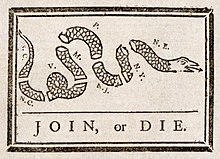
Back Qoşul ya da öl Azerbaijani Join, or Die Breton Join, or Die Catalan Join, or Die Spanish Join, or Die Basque اتحاد یا فنا Persian Join, or Die French Join, or Die Armenian Join, or Die ID Join, or Die Italian

Join, or Die. is a political cartoon showing the disunity in the American colonies, originally in the context of the French and Indian War in 1754. Attributed to Benjamin Franklin, the original publication by The Pennsylvania Gazette on May 9, 1754,[1] is the earliest known pictorial representation of colonial union produced by an American colonist in Colonial America.[2] It was based on a superstition that if a snake was cut in pieces and the pieces were put together before sunset, the snake would return to life.
The cartoon is a woodcut showing a snake cut into eighths, with each segment labeled with the initials of one of the American colonies or regions. New England was represented as one segment, rather than the four colonies it was at that time. Delaware was not listed separately as it was part of Pennsylvania. Georgia, however, was omitted completely. As a result, it has eight segments of a snake rather than the traditional 13 colonies.[3] The poster focused solely on the colonies that claimed shared identities as Americans. The cartoon appeared along with Franklin's editorial about the "disunited state" of the colonies and helped make his point about the importance of colonial unity. It later became a symbol of colonial freedom during the American Revolutionary War.
- ^ "Join, or Die". Pennsylvania Gazette. Philadelphia. May 9, 1754. p. 2. Retrieved January 19, 2014 – via Newspapers.com.

- ^ Margolin, Victor (1988). "Rebellion, Reform, and Revolution: American Graphic Design for Social Change". Design Issues. 5 (1): 59–70. doi:10.2307/1511561. JSTOR 1511561.
- ^ "Join or Die Snake Historical Flag". Flags Unlimited. Archived from the original on July 26, 2011. Retrieved May 13, 2011.